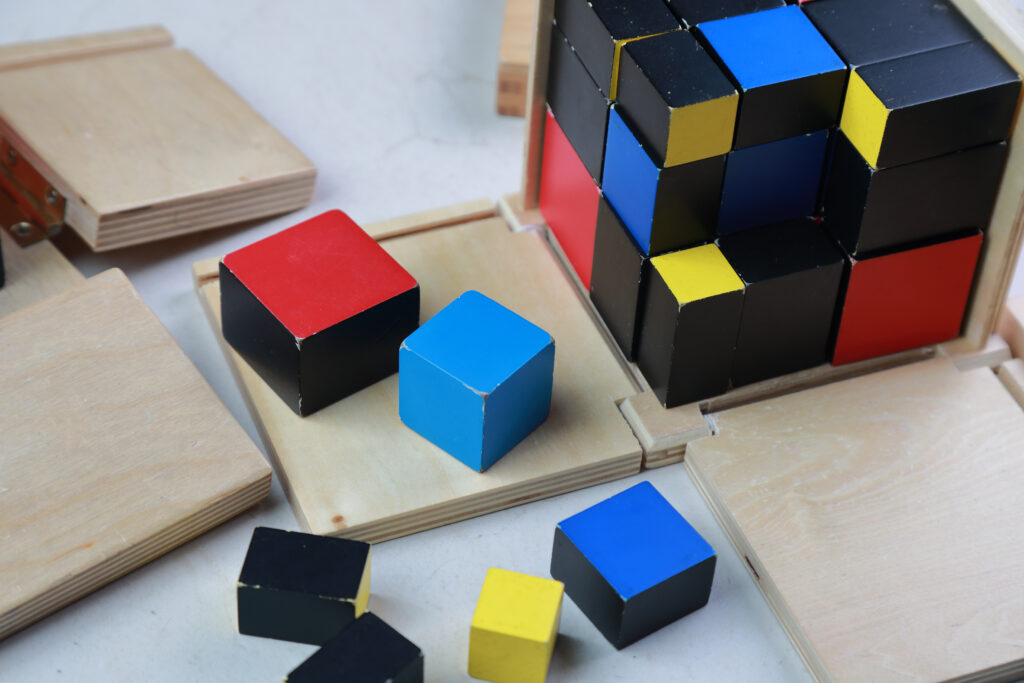Montessori, a method of education that focuses on sensorial exploration and learning concepts from concrete to abstract, uses materials that can sometimes look complicated – the Montessori Trinomial Cube being one such material.
The Trinomial Cube is deceivingly simple to introduce to a child, however. And the activities with this sensorial material are engaging and fun for young children.
In this article, you will learn about the Trinomial Cube material and what it is used for in Montessori. You will also learn how to present this material to a child.
So, let's get right to it.

(This post contains affiliate links. Purchasing from these links costs you nothing extra, but helps with our website upkeep.)
What is the Montessori Trinomial Cube?
The Montessori Trinomial Cube is a sensorial material that consists of colored wooden blocks inside of a hinged wooden box.
The cube is made up of 27 blocks – 3 cubes and 24 prisms.
The child is to deconstruct and reconstruct the Trinomial Cube using a certain method and noting certain characteristics of the material along the way, specifically the pattern of the blocks.
The Trinomial Cube is generally introduced toward the middle or end of a child's second year of a Montessori primary program.
The purpose of this material is to help develop a child's visual discrimination, one of the 9 senses Montessori focuses on.
Through their work with this material, children also get the chance to work in a hands-on fashion with the trinomial expression.
By the time a child is ready to work with this material, they have already worked with something similar – the Binomial Cube.
The concept of the Trinomial Cube lesson is similar to that of the Binomial Cube lesson; the child pieces the blocks together to form patterns and reconstruct the cube.
Introducing this material to a child should be significantly less intimidating to teachers and caregivers, as the material and lessons are already somewhat familiar.
As with the Binomial Cube lesson, the child is not introduced to any algebraic or advanced math vocabulary. They are to simply complete the puzzle, as this is not a math lesson.
Purpose of the Montessori Trinomial Cube Lesson
- to refine visual discrimination (color, pattern, shape)
Indirect aims
- sensorial engagement with the trinomial expression
Control of error
- the matching pattern on the top of the lid
Points of interest
- noticing the binomial while building the trinomial
- the repeating patterns
How to present the Montessori Trinomial Cube Lesson
Note: Prior to presenting this activity, you should make sure the cube is constructed properly in its box.
Any time the pattern of the Trinomial Cube has been exposed or created, give the child time to recognize and comment on it.
- Invite the child to carry the Trinomial Cube box carefully to the table.
- Place the box toward the upper left area of the workspace, oriented to where the sides fold down toward the child.
- Put the lid on the table in front of the child so the pattern on the top matches the pattern of the top layer of the cube.
- Fold down the sides of the box and show the child the pattern on each side.
- Slide the lid into the corner formed by the sides of the box. (Optional step, though many find this helpful.)
- Place the yellow cube from the top layer of the cube on the table in front of the child, then follow with the rest of the blocks from this layer (left-to-right and top-to-bottom), recreating the pattern on the table.
- Slide the finished layer toward the top of the workspace.
- Repeat this step with the middle and then bottom layers.
- Take the red cube from the bottom layer and form a column, sliding each block from the layer, in its orientation above the previous block. (Refer to the image in the Binomial Cube post.)
- After the column has been formed, place the blocks from the column, starting with the red cube, onto the lid in their proper positions.
- After the pattern has been created on the lid, move the blocks in the same order into the box.
- Repeat forming a column, building the pattern on the lid, and building the pattern in the box with the other 2 layers. (In order)
- Close the sides of the box and replace the lid, then invite the child to try the activity for themselves.
Trinomial Cube extension activities
- Building the Trinomial Cube without the lid as a guide.
- Cross-sectioning the cube and exploring.
- The Trinomial Expression. Laying out the blocks as follows, in left-to-right columns, and letting the child make observations: 1 red cube, 3 tall red/black blocks, 3 short red/black blocks, 3 tall blue/black blocks, 6 black blocks, 3 tall yellow/black blocks, 1 blue cube, 3 short blue/black blocks, 3 short yelow/black blocks, and 1 yellow cube.
Both the Binomial and Trinomial Cubes are a lot of fun to introduce to children, no matter the setting – classroom or homeschool.
Children just see these activities as fun and challenging puzzles and that's really the beauty of the Montessori Method – encouraging the enjoyment of learning through no-pressure exploration.
Cheers and don't forget to subscribe!


Thanks
How does it actually represent the trinomial algebraic equation? Thanks!
This is a good explanation:
https://www.montessoriseries.com/2020/05/trinomial-cube-lesson/